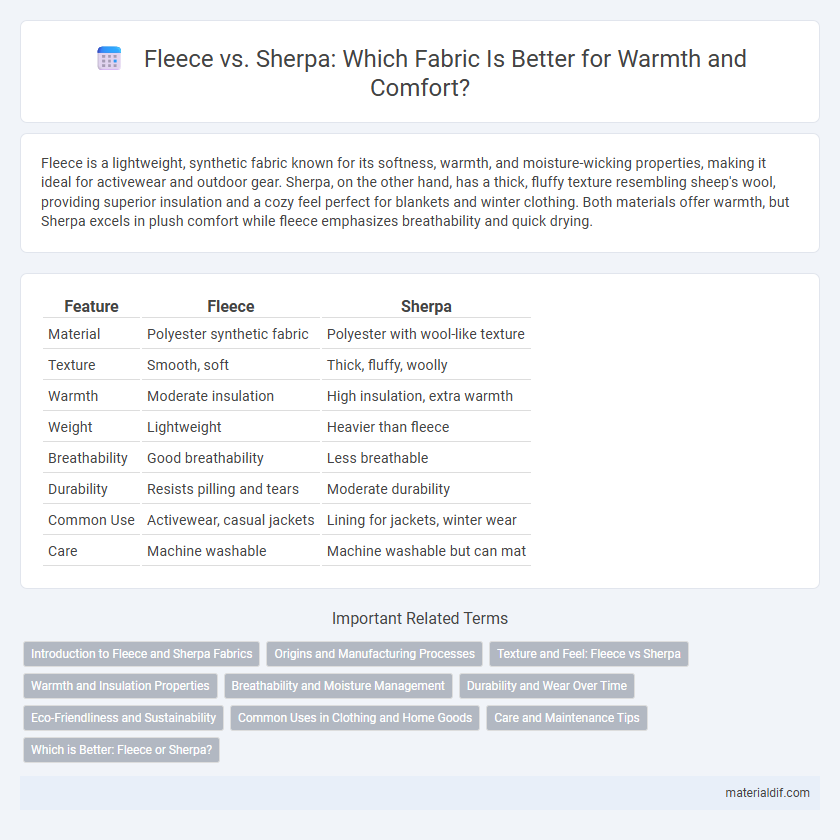Fleece is a lightweight, synthetic fabric known for its softness, warmth, and moisture-wicking properties, making it ideal for activewear and outdoor gear. Sherpa, on the other hand, has a thick, fluffy texture resembling sheep's wool, providing superior insulation and a cozy feel perfect for blankets and winter clothing. Both materials offer warmth, but Sherpa excels in plush comfort while fleece emphasizes breathability and quick drying.
Table of Comparison
| Feature | Fleece | Sherpa |
|---|---|---|
| Material | Polyester synthetic fabric | Polyester with wool-like texture |
| Texture | Smooth, soft | Thick, fluffy, woolly |
| Warmth | Moderate insulation | High insulation, extra warmth |
| Weight | Lightweight | Heavier than fleece |
| Breathability | Good breathability | Less breathable |
| Durability | Resists pilling and tears | Moderate durability |
| Common Use | Activewear, casual jackets | Lining for jackets, winter wear |
| Care | Machine washable | Machine washable but can mat |
Introduction to Fleece and Sherpa Fabrics
Fleece fabric is a lightweight, synthetic material known for its warmth, softness, and moisture-wicking properties, commonly made from polyester fibers. Sherpa fabric mimics the texture of sheep's wool with its thick, plush pile, providing enhanced insulation and a cozy feel, often used in linings and outerwear. Both fabrics are popular in cold-weather clothing, but fleece offers breathability while Sherpa emphasizes maximum warmth and comfort.
Origins and Manufacturing Processes
Fleece fabric originated in the 1970s as a synthetic polyester material developed by Malden Mills, designed to mimic the insulating properties of wool while being lightweight and quick-drying. Sherpa fabric traces back to traditional Tibetan wool garments, with manufacturing involving thick, curly pile knit or woven polyester that replicates the plush texture of sheepskin. Fleece is produced through a process of knitting polyester fibers then brushing to create a soft nap, whereas sherpa is created by tufting or knitting loops that form dense, textured pile on one side of the fabric.
Texture and Feel: Fleece vs Sherpa
Fleece fabric features a smooth, soft texture with a lightweight and breathable feel, making it ideal for activewear and layering. Sherpa has a plush, thick, and wool-like texture that provides superior warmth and a cozy, cushioned comfort often used in linings and outerwear. The distinct tactile difference lies in fleece's sleek surface versus sherpa's dense, nubby pile offering enhanced insulation.
Warmth and Insulation Properties
Fleece fabric offers excellent warmth through its synthetic polyester fibers that trap air, providing lightweight insulation ideal for active wear. Sherpa, made from plush polyester or wool blends, delivers superior insulation with a thicker, fluffy pile that mimics natural sheep's wool, making it optimal for extreme cold conditions. Both materials retain heat effectively, but sherpa's denser structure ensures enhanced thermal retention and comfort in low temperatures.
Breathability and Moisture Management
Fleece fabric offers good breathability with moisture-wicking properties that help keep the skin dry during physical activities. Sherpa, made from thick, plush fibers, provides superior warmth but is less breathable and tends to retain moisture, making it less effective for moisture management. Choosing fleece over sherpa improves airflow and moisture evaporation, ideal for activewear and layering.
Durability and Wear Over Time
Fleece is known for its lightweight durability, maintaining its softness and insulating properties even after multiple washes, making it ideal for active wear and outdoor use. Sherpa, with its thick, plush texture, offers superior warmth but may show signs of matting and reduced loft after prolonged wear and frequent laundering. Choosing between fleece and sherpa depends on whether long-term wear resilience or maximum warmth is the priority in fabric performance.
Eco-Friendliness and Sustainability
Fleece is typically made from synthetic fibers like polyester, which are derived from non-renewable petroleum sources and can contribute to microplastic pollution during washing. Sherpa fabric, often crafted from recycled polyester or blended with natural fibers, offers a more sustainable option by utilizing recycled materials that reduce landfill waste. Choosing Sherpa made from recycled content supports eco-friendly practices by lowering carbon footprints and promoting circular fashion principles.
Common Uses in Clothing and Home Goods
Fleece is commonly used in outdoor and activewear due to its lightweight warmth and moisture-wicking properties, ideal for jackets, hoodies, and blankets. Sherpa fabric, with its dense, plush texture, is popular for linings in coats, gloves, and cozy home items like throws and cushions. Both fabrics provide insulation, but fleece suits performance garments while sherpa enhances comfort and style in casual wear and home textiles.
Care and Maintenance Tips
Fleece fabric requires gentle machine washing in cold water to maintain its softness and prevent pilling, while sherpa demands extra care with low heat drying or air drying to avoid matting and loss of plush texture. Avoid bleach and fabric softeners on both materials to preserve their fibers and enhance longevity. Regularly brushing sherpa with a soft brush can restore its fluffy appearance, whereas fleece benefits from turning inside out before washing to reduce abrasion.
Which is Better: Fleece or Sherpa?
Fleece offers lightweight warmth and excellent moisture-wicking properties, making it ideal for activewear and layering. Sherpa provides superior insulation with its thick, plush texture, making it better suited for cozy, heavy-duty cold-weather garments. Choosing between fleece and sherpa depends on the need for breathability versus maximum warmth and softness.
fleece vs sherpa Infographic

 materialdif.com
materialdif.com